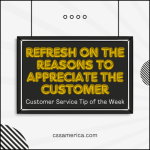
Are you ever been exhausted at the end of a day? How about the end of a conversation with a co-worker? Are you worn out by a tough talk with a difficult customer? Maybe the effort you put into the day, the stubbornness of a co-worker, or the attitude of the customer just wore you down. Or – just maybe – your own emotions that bubbled up are what wore you down.
Ever wonder why pro golfers are noted as being so steady, so calm? Some of that is because it helps them to focus on the immediate task at hand – the next putt, the next drive, visualizing the next shot. They can’t have the quality of what they’re about to do negatively impacted by what they just did (even if it was a good shot). But they also are walking and swinging for 4 hours straight, and they need to have strong energy of body and mind on the 18th hole just like they did on the 1st hole.
Emotions take energy.
When we teach classes on how to defuse the upset customer or co-worker, we talk about letting the other person vent – let them blow off steam. Once they’re given time to vocalize their concerns, many naturally settle down. Why? Because they’re tired – they just expended a lot of energy through their emotional outpouring.
So there are two lessons to learn here – First, realize that when you expend emotions when engaging others, it’s going to take some of your energy. Emotions are wonderful things when channeled for good, so ensure that you’re saving that emotional energy for times when you want to celebrate and do for others or pat yourself on the back. Try not to let yourself get so emotionally involved in things that don’t deserve your energy. Focus on the task, the details, the next steps – convey you care without carrying emotions into everything you do.
Second, use the knowledge of the emotions-energy link during tough customer and co-worker conversations. Realize that allowing the other to vent helps to wear out the other and bring their emotions down. Conserve your energy as they expend theirs; then you can work from a lower key and more objective position to start resolving issues.
On those low energy days and during those tough talks, remember that Emotions Take Energy.
Signup for FREE Tips! Contact Us More Resources for You Visit Our Home Page























